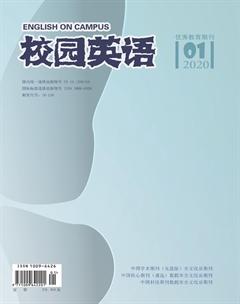An Empirical Study on Chinese EFL Classroom Question-Answer Discourse
Li Jiang
Ⅰ.Introduction
Discourse analysis is connected with “the study of the relationship between the context in which it is used” (McCarthy, 1991:5). The study of language in EFL classroom is a branch of discourse analysis. In the EFL classroom, English language is “both vehicle and the object of instruction”, and “question-answer is a basic interactive structure” (Coulthard, 1985:7) accounting for much of the class time. This study tries to investigate the functions and structures of question-answer discourse from a pragmatics perspective in Chinese EFL classroom. Some key theories of pragmatic basis such as speech act theory, cooperative principle, and politeness principle will be investigated for analyzing the collected data. To achieve this objective, this empirical study will employ the following instruments: classroom observation, questionnaire, and interview to teachers and students. The purpose of the study is to draw attention to different functions and structures of question-answer classroom discourse, and to offer implications for teaching and learning English in Chinese EFL classroom.
Ⅱ.Background
Classroom discourse is concerned with the language of achieving educational purposes between teachers and students in a particular educational context, and its significance is reflected in the completion of the teaching objectives (Walsh 2006). The structure, pattern, quality, and flows of classroom discourse directly affect students learning opportunities and quality. (Seedhouse 2004). The purpose of classroom discourse is precisely to optimize the teaching effect in the classroom environment to a large extent. As Cazden (1988:99) said, we must consider how they affect invisible thought process of the classroom discourse participants by visible classroom discourse, and in turn affect the nature of what they have learned. This is particularly important for foreign language teaching, because discourse assumes a dual role in a foreign language classroom: is not only the learning content and objectives, but also the learning method. (McCarthy & Carter 1994; Seedhouse 2004). Consequently, this also makes the study of a foreign language more complicated, and more difficult.
Most studies have the similar conclusion: classroom discourse can promote the occurrence of effective learning and enhance the students learning level under two circumstances. One circumstance is when the students actively participate in the construction and generation of knowledge, and the other circumstance is when the classroom discourse is highly interactive, whats more, the occurrence of two circumstances is closely related to the code of questioning in classroom discourse by teachers.
Ⅲ.Aims of the present study
The objectives of this study are to investigate the question-answer in classroom discourse of Chinese EFL classroom. The research questions directing the investigation are:
What are the functions and structures of questions occurring in Chinese EFL classroom?
What are the question-answer interplay patterns in Chinese EFL classroom?
What are the implications for the EFL teaching and learning in view of Chinese question-answer classroom discourse?
Ⅳ.Method
1. Samples. The Chinese EFL students chosen for this investigation will be from School of Foreign Languages, Hangzhou Normal University. Undergraduate Students of English majors will be selected, who have the basic knowledge and skills of learning a foreign language. The research will choose intensive English courses in Chinese EFL classroom. Intensive English courses are core courses in domestic undergraduate college English skills courses, and occupy a significant position in the English majors training. The Chinese teachers will be selected by some outstanding teachers.
2. Instruments. Observation by recording will be carried out, and then we have a questionnaire for students. After the analysis of some data about the observation and questionnaire, the interview will be taken to the involving teachers. This empirical study via “the collection of data by observation or recording in as natural a setting as possible” (Richards, 1998: 173) will help to have a broader knowledge of classroom question and answer discourse.
Observation by recording analysis will use CDA (classroom discourse analysis) software CLASS4.0 (Nystrand1999, 2004), and the analysis of questionnaire and interview will occupy descriptive statistics and thematic analysis (Linde 1980).
Ⅴ.Conclusion
The author found that teachers used referential questions and display questions more frequently than the evaluation and administrative questions in EFL classrooms, which means that there is less initiative communications between teachers and students in EFL classrooms.
From our research, we found that most teachers use only two or three question-answer interplay patterns in Chinese EFL classroom, and each teacher is unique in choosing what type they prefer to use.
Thus, it is imperative that teachers should combine all kinds of question type rather than only use referential and display questions in EFL classrooms. Besides, teachers should pay more attention to pose a question to the entire class, give more efforts to stimulate all students initiative communication in Chinese EFL classroom.

